Top News
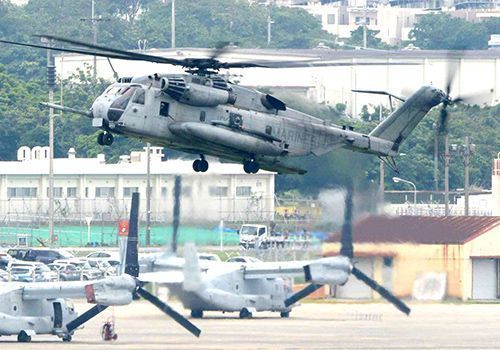
April 17, 2019 Ryukyu Shimpo
The ruling for the appeal in the 2nd Futenma noise pollution lawsuit, in which the 3,415 residents who live in the area around MCAS Futenma filed suit seeking a substantive flight stoppage as well as compensation for both past and future damage, was handed down by the Fukuoka High Court Naha Branch April 16.
Presiding Judge Shodo Okubo, in keeping with the ruling in the initial trial, recognized the illegality of the noise pollution, however he rejected the request to stop flights.
Furthermore, the judge changed the base amount of the monetary compensation, reducing it by over 30%. The judge did order the payment of the previously owed amount of around 2.12 billion yen.
The question of if the U.S. and Japan’s “Futenma Base Agreement” was dismissed.
After the ruling, the plaintiffs held a press conference in Naha. Zenji Shimada, who leads the plaintiff group, said, “Since the amount of the fairly established compensation was been painfully reduced, we cannot approve of this decision,” criticizing the decision.
The counsel group announced that they would be appealing the ruling to a higher court.
In his ruling, Judge Okubo agreed with the original ruling, acknowledging that the residents suffered disruption to their daily lives, mental anguish, and sleep issues due to the noise of U.S. military aircraft.
However, he rejected the claim of damage to resident’s health in the form of an increased risk of hypertension, commenting, “It is difficult to accept that this is caused by noise pollution alone.
” Furthermore, the court reduced the monthly monetary award paid to plaintiffs who experienced 75 or more decibels of noise pollution from 7,000 yen to 4,500 yen, and the award for plaintiffs who experienced 80 or more decibels of noise pollution from 13,000 yen to 9,000 yen.
Future noise pollution damages were not awarded. Also, the claim of an increase in infrasound damage and damage from Osprey helicopters was dismissed, with the court saying, “there is insufficient evidence.”
The court also ruled that the damage suffered by residents outside of the key areas on the noise pollution contour map, “must be deemed relatively smaller than the zones of 75-decibels and above,” and compensation was not awarded.
The request for a flight stoppage was also rejected, with the court agreeing with the previous ruling, stating, “We are not in a position to regulate the flight of U.S. military aircraft.”
The request for a ruling on whether or not the base agreement infringed on the constitution was rejected after being deemed outside the scope of the trial.
In the November 2016 ruling at the Okinawa Branch of the Naha District Court, the 3,395 plaintiffs were awarded damages totaling 2.5 billion yen, however no other demands were granted. Both the plaintiff group of residents and the Japanese central government appealed the ruling.
(English translation by T&CT and Sam Grieb)
Go To Japanese
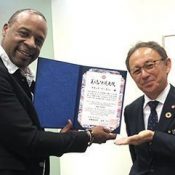
April 19, 2019 Ryukyu Shimpo
The Okinawa Prefectural Government (OPG) has declared American Grammy-winning musical artist Skip Martin, 61, a goodwill ambassador for Okinawa.
At Haneda Airport in Tokyo on April 16, Okinawa Governor Denny Tamaki met Martin to present him with a certificate marking his appointment as a goodwill ambassador.
This is the first time the resident of a foreign country has received this certificate.
Martin commented that in his tours in Japan he came to Okinawa 12 times, and felt as though this was meant to be.
He said he believes that music transcends differences in language and culture.
Lead vocalist and trumpeter of Dazz Band, Martin volunteers in various capacities around Japan, visiting educational institutions and participating in musical cultural exchange.
On April 8, Martin visited Yonabaru Junior High School’s wind instrument ensemble.
He gave vocal and musical demonstrations and instructed the students in music.
Dazz Band released its album “Let It Whip” in 1982, and was awarded a Grammy (best R&B performance by a duo or group with vocal) for the album the following year.
From here on out, Martin plans to volunteer as a goodwill ambassador for Okinawa and involve himself in PR activities that will enhance Okinawa’s image.
(English translation by T&CT and Erin Jones)
Go To Japanese
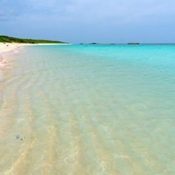
April 18, 2019 Ryukyu Shimpo
On April 16 the Ministry of the Environment (MOE) publicized the results of its 2018 investigation of the dugong habitat.
According to the investigation, on August 22, 2018 two dugong specimens thought to be parent and child were seen from a helicopter at Taketomi Town’s Hateruma Island in the Sakishima Islands.
There is no proof of the sighting, such as a photograph, so it cannot act as verification of the dugong habitat, but a staff member of the 11th Regional Coast Guard Headquarters at Ishigaki Airport also claimed to have spotted the dugong in that area while flying a helicopter.
The MOE stated, “The Sakishima Islands are generally a dugong habitat, so it is not strange for them to be there.
” It also mentioned its intention to continue habitat investigations including underwater audio recording.
An audio recording study concerning the dugong habitat in the Sakishima Islands was last conducted in 2004, 14 years ago.
According to the MOE, the verified dugong habitat has been limited to the vicinity of Okinawa Island since 1970.
Habitat investigation results mention a dugong spotted from an aircraft on June 6, 2013 in the vicinity of Tarama Island in the Sakishima Islands, and kayakers’ eyewitness reports of dugong off the northern shore of Iriomote Island between early spring and summer in 2013 and 2014.
(English translation by T&CT and Erin Jones)
Go To Japanese
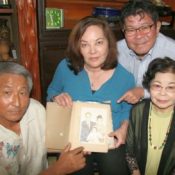
April 19, 2019 Ryukyu Shimpo
By Yousuke Asato
“I’m proud to have connected with Okinawa.”
On April 9, Natalie Ann Yasumine, a second-generation Okinawan descendant from Georgia, arrived in Okinawa with the goal of meeting her relatives, which she accomplished.
She received help from prefectural officials and traced the roots of her mother, who had died young in the U.S. Yasumine left on April 19 to make her way back to the states, but promised to see her relatives again and said, “Next time, I will bring back my siblings and come back to Okinawa.”
In 2014, Yasumine’s father Robert Gene Shack entrusted her with an old document, which kick-started her journey to trace her roots.
The document was the family register for her mother Setsuko (aged 50), who had passed away from cancer in 1990.
Setsuko had met and married Robert, an airman, when she was living in Osaka. They eventually settled down in Connecticut and raised one boy and four girls, including Yasumine who is the third daughter.
But Setsuko hardly spoke about Japan to her children and had never disclosed that she was from Okinawa.
“I wanted to know her life story that was a mystery.”
The fact that her father also passed away at the age of 81 seven-months after receiving the document made her determined to trace her mother’s footsteps since she felt that “It was now or never.”
The family register lists Kochinda Town, which she used to connect with her relatives. She found out that about a group related to the Worldwide Uchinanchu Festival comprised of staff at a prefectural library that helps overseas Okinawan descendants trace their roots.
From there, she connected with Naomi Shinzato, a staff member from Yaese Town, and was able to meet 65-year-old Kiyomasa Arakaki, a relative on her grandfather’s side, in the same town.
Arakaki said, “We were also in the middle of creating a family tree and were trying to gather information on Setsuko.
” Yasumine was also able to meet 53-year-old Satoru Kinjyo, a relative on her grandmother’s side.
Yasumine smiled brightly as she said, “I used to think that something was missing from my life, but I found the answer in Okinawa.
I’m proud to have found family here.”
(English translation by T&CT and Chelsea Ashimine)
Go To Japanese
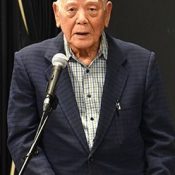
April 4, 2019 Ryukyu Shimpo
Friends of the Okinawa Prefectural Peace Memorial Museum hosted an educational 5K peace walk in Naha City on April 13. The course stretched from “Sugarloaf Hill”, which was the bloodiest battlefield during the Battle of Okinawa, to Shuri Park, where the former underground headquarters of the Japanese 32nd Army is located.
Akio Gima, 91, delivered a talk at the Himeyuri Peace Hall in Asato, Naha City.
Gima fought in the Battle of Okinawa as a Tekketsu Kinnōtai (Iron and Blood Imperial Corps) solider when he was a first-year student at the Okinawa Normal School.
Gina said of the battle, “It was hell on earth.
Construction of military bases, which causes wars, should not be permitted.”
As part of the field fortification unit, Gima was working on a cave near Shuri Castle.
It was when the troop retreated north on May 27, 1945, that he witnessed the war.
“Exiting the cave, there were bodies everywhere, on the streets and in intersections, stacked on top of each other. It looked like hell on earth, there’s no other way to describe it.”
It took Gima nearly three days to reach Mabuni, Itoman City. He remembered “feeling alive for the first time,” upon seeing a sugarcane field.
It wasn’t long before the American troops began its attack and the area was scorched to nothing.
Injured Japanese soldiers lay on the streets begging to be killed, but Gima had “lost sense of humanity.
I just kept heading towards the shore.”
Along the shore, Japanese soldiers and locals were taking cover. Once they were surrounded by American soldiers, they had no choice but to surrender.
“I was ready to die. We were taught to be. I feel guilty to be the only one surviving while my friends lost their lives.”
When the war ended, Gima became an elementary school teacher. Today, he participates in the protest against the construction of the new base in Henoko, Nago City, every Monday morning at the Asato intersection.
Gima said, “People are what start and end wars. I have to share my own experience with the new generation.”
(English translation by T&CT and Monica Shingaki)
Go To Japanese
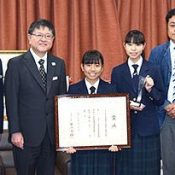
April 12, 2019 Ryukyu Shimpo
On March 29, the Okinawa Shogaku Junior High School was awarded the Ministry of Education, Culture, Sports, Science and Technology (MEXT) Minister Prize (junior high school division) as the entity with the largest number of people nationwide who passed the Eiken exam (levels 1-3).
A total of 570 people at the school passed the exam.
On April 10, the school held a news session for the media, and its representatives discussed their elation at receiving the prize and their efforts toward Eiken preparation.
Some students passed more than one level of the exam; the school announced that of the highest levels, two passed level 1, eight passed level pre-1, 108 passed level 2, 216 passed level pre-2, and 236 passed level 3.
“Our receipt of the prize is the result of all of our students sharing the goal of passing the Eiken, and each and every student doing his or her best. I believe our students’ motivation will increase all the more as a result of being granted the prize,” school principal Masaichiro Nashiro said at the news session, expressing hope for his students’ continued success.
The school made passing the Eiken compulsory in the 2009 school year, and students at the affiliated high school are expected to aim to pass level pre-1 by the time they graduate.
The school endeavors to cultivate English ability that will serve on any test by conducting classes that focus on the four skills of reading, writing, listening, and speaking.
For Eiken preparation, the school has an agreement with a university abroad that sends its teachers there to hold English classes once a week.
“As a member [of the school], I’m very happy.
I want to pass level 2 or higher by the time I graduate junior high school,” said student council president Asahi Nakahodo, age 15, expressing her ambition.
(English translation by T&CT and Sandi Aritza)
Go To Japanese
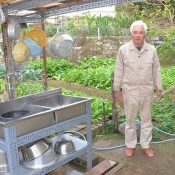
April 12, 2019 Ryukyu Shimpo
By Maki Nagamine
Perfluorooctane sulfonate (PFOS) and perfluorooctanoic acid (PFOA), the use of which chemicals is principally prohibited within Japan, have been detected at high concentrations in spring water and other water sources in the vicinity of the Marine Corps Air Station Futenma (MCAS Futenma).
Residents of Ginowan City are expressing their uneasy feelings at this. The U.S. military is not allowing examinations within the base compound, and there are no signs that this situation will improve.
Once the chemicals were detected, some residents stopped using the water on their agricultural plots. Some people are calling for the Ginowan City Assembly to put more pressure on Japan and the U.S. to conduct an investigation into the cause of the contamination and clean the water.
This movement is growing in the city.
The OPG has been conducting investigations in the vicinity of MCAS Futenma two times each year since 2016, and it detects high concentrations of PFOS and PFOA downstream of the base each time.
Due in part to a foam fire extinguishing agent used on the air station in the past, the Okinawa Prefectural Government (OPG) expressed its opinion that, “It is exceedingly likely that it came from Futenma Air Station.”
PFOS and PFOA are likely carcinogens. Although Japan has no environmental standard value concerning concentrations of PFOS and PFOA, in the U.S. the Lifetime Health Advisory Level (HAL) is set at 70 nanograms per liter (ng/L) of drinking water.
Concentrations greatly exceeding this level are frequently detected in the drinking water in Ginowan City. In August and September last year, 2,000 ng/L were detected in Kiyuna’s Chunnaga Fountain. The OPG said, “If it is not directly consumed, it will not be an issue to people’s health.”
Even if it is said to be fine…
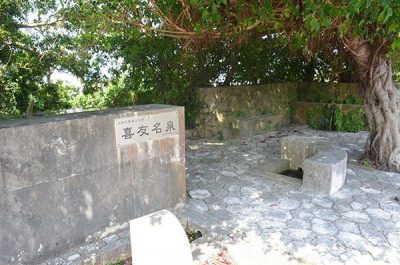
The Chunnaga Fountain (Kiyuna Spring) has supported area residents’ lives since before WWII, and has become an object of faith.
Kosei Gushiken, 85, voiced his concerns: “No matter how many times it is said to be fine, it still concerns me. I cannot give the vegetables I’ve grown to my grandchild.”
Gushiken has been cultivating about 20 types of crops in Kiyuna over the course of more than 40 years.
Kiyuna residents used to make round trips to and from Chunnaga to carry in water before the war, and in 1957 they laid pipes to conveniently bring in water from Gaa. According to concerned persons, over 100 households still use this pipe system.
However, PFOS and PFOA contamination was detected about three years ago. Gushiken stopped watering his plots with the contaminated water, and now only uses it when he washes his hands or agricultural equipment. He said, “The U.S. military or the Ministry of Defense should remove the contaminants.
Can’t the city and prefecture demand this more firmly?”
High concentrations of PFOS and PFOA continue to be found, even in spring water in the Oyama region where taimo potatoes are produced, a Ginowan specialty.
One time when the OPG conducted an investigation in 2016, the contaminants were not detected in the taimo.
Still, there is deep-seated concern in the region about the extent of the damage.
One 55-year-old man from Oyama who has been cultivating taimo for about 20 years said, “Regardless of the levels, there is no doubt [the chemicals] are toxic. The U.S. military should remove [the contaminants].”
He went on to request that the OPG conduct periodic examinations on the taimo and make the results public.
Also, he is calling for it to collect water for use in one place, and purify it to do away with contaminant damage.
Ginowan as a Concerned Party
Whenever the Ginowan City Assembly has a regular meeting it receives many questions about how Ginowan will handle the situation. People make calls for stronger actions such as, “I want stronger demands to the U.S. military to restore our water to its original state,” and “We should conduct a fact-finding survey, ourselves.”
Contrary to these calls, the city is prioritizing the OPG request that Japan and the U.S. military establish of a place for concerned parties to coordinate, and repeatedly responds, “We want to steadily develop this request.”
The Assembly called for the U.S. military to provide information concerning PFOS and PFOA. Yet in regard to the origin of the contaminants, the Assembly stated its perception that it is difficult to specify a particular region as the source and made no reference to MCAS Futenma.
Again in December last year, Ginowan sought an explanatory meeting about contamination from the Kiyuna Neighborhood Association.

However, the Association did not hold the meeting, giving its reason that the OPG is conducting the bulk of the investigation. Hideaki Chinen, 45, an official of Kiyuna Ward and a Ginowan City Assembly member, said, “It is difficult for the ward [Kiyuna] to directly appeal to the U.S. military and Japan.
I want to work more closely with city residents.”
In October last year the research group called the Informed-Public Project (IPP) submitted a statement titled “Questioning Ginowan City’s Status as a Concerned Party” to Ginowan City.
Having discussed with experts, city residents and others, the IPP is demanding a fact-finding survey including actions such as defining the scope of contamination and discussing appropriate concentration levels.
IPP Director Masami Kawamura pointed out, “Accumulated contaminants are currently oozing off of the base, so this should be dealt with as soon as possible.
Because the site of the former base will be used in the future, the city must also make a request to the U.S. military, and pursue countermeasures on the base.”
Concerning investigation into the contamination, Kawamura said, “If it is going to be called safe, entities such as the city and prefecture must at least investigate. The OPG has only examined Oyama’s taimo once, which is far from adequate.”
(English translation by T&CT and Erin Jones)
Go To Japanesez
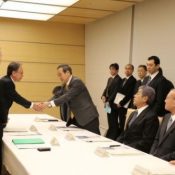
April 11, 2019 Ryukyu Shimpo
Tokyo – Representatives from the Japanese government, the Okinawa prefectural government, and Ginowan City met April 10 at the prime ministers offices for a conference to further the lessening of the burden brought by MCAS Futenma.
At the conference, the conversation surrounding the deadline to “end operations [at MCAS Futenma] within five years,” which the Japanese government had previously promised Okinawa before walking it back in February, was re-opened, with the three parties agreeing to work towards a new deadline.
Meanwhile, Okinawa Governor Denny Tamaki requested that the Japanese government agree to a timeline for removing the dangers posed by Futenma of around 3-6 months, which was requested with the assumption that new facility construction at Henoko in Nago would be cancelled.
The Japanese government representatives did not give a definitive answer to this request, with both parties once again digging into their respective trenches.
The first meeting was held two years and nine months ago in July of 2016, making this the first meeting since the elections of both Tamaki and Ginowan Mayor Masanori Matsukawa.
Okinawa’s representatives at the meeting were Governor Tamaki and Mayor Matsukawa, while the representatives from the Japanese government were Chief Cabinet Secretary Yoshihide Suga, Minister for Foreign Affairs Taro Kono, Minister of Defense Takeshi Iwaya, and Minister of State for Okinawa and Northern Territories Affairs Mistuhiro Miyakoshi.
At the conference, Mayor Matsukawa said that the withdrawal in February of the promise of a deadline to close the base was, “truly regrettable,” and requested a new deadline be set.
To this, Deputy Chief Cabinet Secretary Kazuhiro Sugita responded that the setting of a new deadline was essential, commenting, “We would like to set up a task force, and move this ahead pragmatically.” Conversely, when Governor Tamaki brought up creating a mechanism for discussing the removal of the danger caused by the presence of MCAS Futenma, the government representatives gave no response.
When the governor similarly notified the government the results of a prefectural referendum in Okinawa that resulted in a strong majority opposing new base construction before proposing setting up a conference between the U.S., Japan, and Okinawa called SACWO (SACO with Okinawa), the Chief Cabinet Secretary only commented, “the governments of both countries continue discussions,” declining the new conference.
After the summit, Governor Tamaki said regarding the reduction of burden caused by the U.S. bases, “The next step is getting an agreement from those who will actually carry out the shutdown. Go
I expect that we can work to an earnest agreement.” Mayor Matsukawa said, “Today is a new start, and I want to continue working towards lessening the burden from the bases.”
With the exception of the beginning, the meeting was held closed to the press.
(English translation by T&CT and Sam Grieb)
Go To Japanese
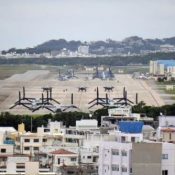
April 12, 2019 Ryukyu Shimpo
In 2018, Ginowan City, Okinawa Prefecture received 684 complaints pertaining to the aircraft noise from the U.S. Marine Corps Air Station Futenma.
This is a record high since Ginowan City began accepting complaints in 2002.
The number of complaints from 2018 is 50 percent higher than that of 2017, and there are even records showing aircrafts noises at over 120 decibels.
For five years in a row, the number of complaints has continued to grow.
The number of complaints from 2018 surpasses the 549 complaints from 2011 when there was a flood of complaints about radio disturbances when people were switching to terrestrial digital broadcasting.
April 12 marked 23 years since Japan and the U.S. agreed to return the Air Station Futenma land back to Japan.
The current situation has made it clear once again that local residents are reaching their mental and physical limits due to the burden of hosting a military base.
It seems that the main cause lies in increased number of flights by transient aircrafts, such as the state of the art short take-off and vertical landing (STOVL) stealth fighter F-35B, for training purposes.
There are many complaints about night flights.
It became distinctly apparent that noise regulatory measures to restrict training during the early mornings and nighttime were reduced to a formality.
Local residents continue to complain that the helicopters circling are extremely loud and that they are mentally drained because the aircrafts are flying at night.
The city continues to accept complaints about damages incurred by the base 24 hours a day.
According to a visual study by the Okinawa Defense Bureau, the number of takeoffs and landings by transient aircrafts between April 2018 and February 2019 were 1,455.
That is 1,040 more times than numbers from 2017 when the study started. According to the city’s data, the number of aircraft noise occurrences for 2017 was 12,152.
The loudest aircraft noise from 2018 was recorded in Ojanaku at 123.7 decibels during the day and 100.1 decibels at night.
120 decibels corresponds to being close to an airplane engine, while 100 decibels corresponds to being up close to an ambulance siren.
On April 12, 1996, the Japanese and American governments agreed to return the Air Station Futenma land back to Japan “within 5 to 7 years.”
But the opposition against relocating the base within Okinawa is deeply rooted.
Even after 23 years, the said air station continues to be used and there have been a series of accidents by aircrafts that belong to the same base.
In the name of being the “only solution,” the government continues to move forward with the Henoko base construction.
But Okinawa is requesting that the base be relocated to outside of Okinawa or Japan since merely relocating the base will not lead to an early return of Air Station Futenma.
(English translation by T&CT and Chelsea Ashimine)
Go To Japanese
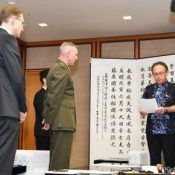
April 15, 2019 Ryukyu Shimpo online edition
On April 13 the dead bodies of a U.S. Navy sailor assigned to a Marine unit in Okinawa and a Japanese woman were found in an apartment in Kuwae, Chatan Town. It appears the sailor fatally stabbed the woman and killed himself. Okinawa Governor Denny Tamaki called Okinawa Area Coordinator (OAC) Eric Smith and Consul General of the U.S. to Naha Robert Koepcke to the Prefectural Office on April 15, and made a protest to these U.S. military officials regarding the incident.
Governor Tamaki touched on the 2016 incident in which a young Okinawan woman was sexually assaulted and killed by a former Marine, saying, “With that still fresh in our memory, the occurrence of this kind of incident causes many Okinawans to feel great apprehension and resentment.”
In February this year the U.S. military in Okinawa loosened the restrictions of the Liberty Policy, which regulates the activity of U.S. soldiers when they are off-duty. Even in light of this incident OAC Smith did not express any intent to reinstate these regulations as a countermeasure to future incidents.
In response to the incident Governor Tamaki said, “I want the entire military to tighten discipline and conduct human rights education to remove the apprehension it causes Okinawans.” He demanded that the U.S. military and U.S. and Japanese governments take responsibility by taking drastic preventative measures. Additionally, he spoke about the U.S. military in Okinawa relaxing the Liberty Policy, saying he wants the circumstances verified. He mentioned that although Okinawans are always demanding tighter discipline, Mr. Smith called it his responsibility over the phone. Because of this, Governor Tamaki thinks the U.S. military will thoroughly investigate and dependably communicate.
OAC Smith offered an apology over the matter, and expressed willingness to completely cooperate with the prefectural police’s investigation.
(English translation by T&CT and Erin Jones)
Go To Japanese
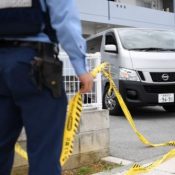
April 14, 2019 Ryukyu Shimpo
On the morning of April 13 a 44-year-old Japanese woman and a 32-year-old U.S. Navy sailor assigned to a Marine Corps unit in Okinawa were found dead in a bloody apartment bedroom in Kuwae, Chatan Town.
According to the prefectural police, there are signs indicating that the naval sailor killed the woman and committed suicide.
Prefectural police are investigating circumstances surrounding the deaths.
The two are believed to have had a relationship.
According to the prefectural police, at around 7:25 a.m. they received an emergency call reporting, “It seems there is some trouble.”
A rescue team from the Nirai Fire Department rushed to the scene, and confirmed the death of two persons.
The two were bloodied and collapsed on the bed, and their bodies appeared to have stab wounds. A knife with bloodstains was also found in the room.
There is no evidence that anyone invaded the room from the outside, and it appears that the naval sailor was with the woman at her home from at least the night of April 12.
The woman’s small daughter was home with them, and found the two dead. She contacted a relative, who then made the emergency call to the police.
The U.S. Marine Corps in Okinawa explained to a Ryukyu Shimpo reporter that it was a very sad case where a navy sailor assigned to the 3rd Marine Division and an Okinawan woman died, and that it would cooperate fully with the investigation.
It added that the Naval Criminal Investigation Service (NCIS) is investigating with the prefectural police.
Takeo Akiba, the Japanese vice minister of foreign affairs, protested to the United States ambassador to Japan William F. Hagerty on a phone call.
He sought U.S. cooperation in the investigation, the enforcement of official discipline, and recurrence prevention.
The Ministry of Defense also protested to the commander of the U.S. Forces, Japan, and the Okinawa Area Coordinator (Commanding General of III Marine Expeditionary Force).
The crime scene is located in a residential area near Route 58. It is close to the U.S. military bases, and many foreigners live in nearby housing complexes.
(English translation by T&CT)
Go To Japanese













 Webcam(Kokusai Street)
Webcam(Kokusai Street)


